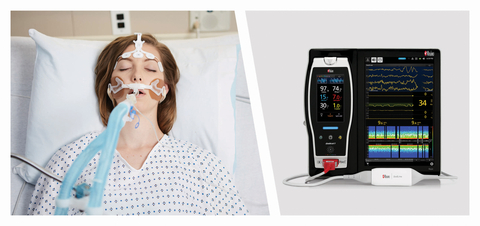Masimo SedLine® Brain Function Monitoring Reduced the Use of Anesthetic Agents and Opioids in a Study on Patients Undergoing Cardiac Surgery
Masimo (NASDAQ: MASI) announced results from a study published in the Journal of Cardiothoracic and Vascular Anesthesia showing that using SedLine Brain Function Monitoring during cardiac surgeries significantly reduces the need for vasoactive and inotropic drugs. The study involved 300 patients from the Montreal Heart Institute. Key findings included a 57% reduction in higher vasoactive and inotropic scores, shorter mechanical ventilation duration, less intraoperative bleeding, and lower fluid requirements. However, pEEG-guided anesthesia did not improve CPB separation outcomes. Further prospective studies are recommended.
- 57% reduction in higher vasoactive and inotropic scores in pEEG group.
- Shorter duration of mechanical ventilation (3 hours vs. 4 hours) for pEEG patients.
- Less intraoperative bleeding (400 mL vs. 500 mL) in pEEG group.
- Lower central venous pressure and fluid administration in surgeries using pEEG.
- pEEG-guided anesthesia did not improve outcomes for weaning from CPB compared to control.
- Study results may not be independently verified without further research.
SedLine Was Also Associated with Reduction in Bleeding During Surgery and Shorter Duration on Mechanical Ventilation

Masimo Root® with SedLine® Brain Function Monitoring (Photo: Business Wire)
Noting that pEEG-guided anesthesia may improve hemodynamic stability and that high postoperative doses of vasoactive and inotropic drugs have been associated with mortality and renal dysfunction, the researchers sought to determine whether use of pEEG-guided anesthesia might improve outcomes by reducing use of such agents during cardiac surgery and at arrival in the ICU. Their primary goal was to determine whether pEEG-guided anesthesia would be associated with reduced hemodynamic instability during cardiopulmonary bypass (CPB) separation, measured by stratifying the operation into three categories: “easy” (use of only one vasoactive or one inotropic agent), “difficult” (use of at least two different classes of agents), or “complex” (requiring a return to CPB or use of mechanical circulatory support). Their secondary goal was to determine if pEEG-guided anesthesia would lead to the hypothesized reduction in vasoactive and inotropic drug administration in the ICU, measured by vasoactive and inotropic score (VIS).
The researchers compiled a retrospective cohort of 300 adult patients who underwent cardiac surgery using CPB between 2013 and 2020 at the
In the pEEG group, patients received fewer vasoactive and inotropic drugs in the first hour after ICU admission, resulting in lower VIS scores (pEEG: 5 [0-10], control: 8 [2-15], p=0.003). Being in the pEEG group reduced the odds of being in a higher VIS category by
A lower proportion of patients experienced unsuccessful (difficult or complex) CPB separation in the pEEG group than the control group (
The researchers concluded, “pEEG-guided anesthesia is associated with a reduction in the use of inotropic or vasoactive drugs at arrival in the ICU. In addition, its implementation was associated with lower requirements of anesthetic agents and opioids in the OR, lower CVP, fluid requirements, intraoperative bleeding, and shorter duration of mechanical ventilation. However, its use did not facilitate weaning from CPB compared to a group where pEEG was unavailable. Future research is needed to confirm these results in prospective randomized clinical trials.”
@Masimo | #Masimo
About Masimo
ORi and RPVi have not received FDA 510(k) clearance and are not available for sale in
References
-
Jarry S, Halley I, Calderone A, Momei M, Deschamps A, Richebé P,
Beaubien-Souligny W , Denault A, Couture E. Impact of Processed Electroencephalography in Cardiac Surgery: A Retrospective Analysis. J Cardio Vasc Anesth.March 2022 . DOI: 10.1053/j.jvca.2022.03.030 - Published clinical studies on pulse oximetry and the benefits of Masimo SET® can be found on our website at http://www.masimo.com. Comparative studies include independent and objective studies which are comprised of abstracts presented at scientific meetings and peer-reviewed journal articles.
- Castillo A et al. Prevention of Retinopathy of Prematurity in Preterm Infants through Changes in Clinical Practice and SpO2 Technology. Acta Paediatr. 2011 Feb;100(2):188-92.
- de-Wahl Granelli A et al. Impact of pulse oximetry screening on the detection of duct dependent congenital heart disease: a Swedish prospective screening study in 39,821 newborns. BMJ. 2009;Jan 8;338.
- Taenzer A et al. Impact of pulse oximetry surveillance on rescue events and intensive care unit transfers: a before-and-after concurrence study. Anesthesiology. 2010:112(2):282-287.
- Taenzer A et al. Postoperative Monitoring – The Dartmouth Experience. Anesthesia Patient Safety Foundation Newsletter. Spring-Summer 2012.
-
McGrath S et al. Surveillance Monitoring Management for General Care Units: Strategy, Design, and Implementation.
The Joint Commission Journal on Quality and Patient Safety . 2016 Jul;42(7):293-302. - McGrath S et al. Inpatient Respiratory Arrest Associated With Sedative and Analgesic Medications: Impact of Continuous Monitoring on Patient Mortality and Severe Morbidity. J Patient Saf. 2020 14 Mar. DOI: 10.1097/PTS.0000000000000696.
- Estimate: Masimo data on file.
- http://health.usnews.com/health-care/best-hospitals/articles/best-hospitals-honor-roll-and-overview.
Forward-Looking Statements
This press release includes forward-looking statements as defined in Section 27A of the Securities Act of 1933 and Section 21E of the Securities Exchange Act of 1934, in connection with the Private Securities Litigation Reform Act of 1995. These forward-looking statements include, among others, statements regarding the potential effectiveness of Masimo SedLine®. These forward-looking statements are based on current expectations about future events affecting us and are subject to risks and uncertainties, all of which are difficult to predict and many of which are beyond our control and could cause our actual results to differ materially and adversely from those expressed in our forward-looking statements as a result of various risk factors, including, but not limited to: risks related to our assumptions regarding the repeatability of clinical results; risks related to our belief that Masimo's unique technologies, including SedLine, contribute to positive clinical outcomes and patient safety; risks that the researchers’ conclusions and findings may be inaccurate; risks related to our belief that Masimo noninvasive medical breakthroughs provide cost-effective solutions and unique advantages; risks related to COVID-19; as well as other factors discussed in the "Risk Factors" section of our most recent reports filed with the
View source version on businesswire.com: https://www.businesswire.com/news/home/20220425005259/en/
Media:
Masimo
949-396-3376
elamb@masimo.com
Source: Masimo
FAQ
What were the findings of the Masimo study on SedLine (MASI)?
How does pEEG-guided anesthesia impact patient recovery in cardiac surgery?
What was the sample size of the Masimo SedLine study?
When was the study on SedLine published?







